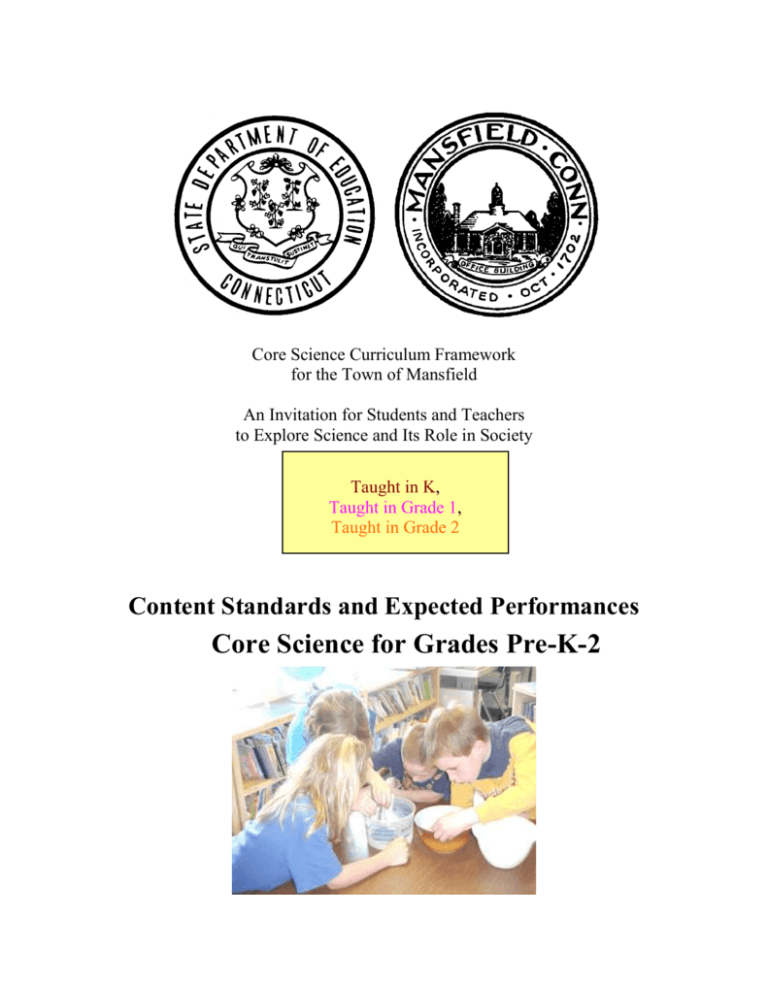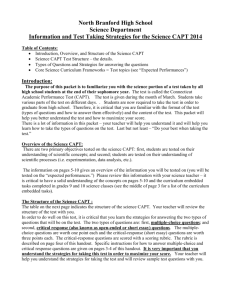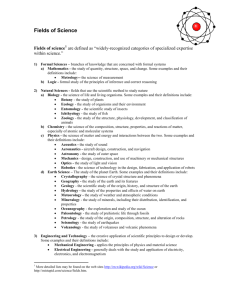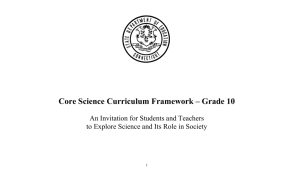Core Science Curriculum Framework
advertisement

Core Science Curriculum Framework for the Town of Mansfield An Invitation for Students and Teachers to Explore Science and Its Role in Society Taught in K, Taught in Grade 1, Taught in Grade 2 Content Standards and Expected Performances Core Science for Grades Pre-K-2 THE STANDARDS FOR SCIENTIFIC INQUIRY, LITERACY AND NUMERACY ARE INTEGRAL PARTS OF THE CONTENT STANDARDS FOR EACH GRADE LEVEL IN THIS CLUSTER. Grades PreK-2 Core Scientific Inquiry, Literacy and Numeracy How is scientific knowledge created and communicated? Content Standards SCIENTIFIC INQUIRY Scientific inquiry is a thoughtful and coordinated attempt to search out, describe, explain and predict natural phenomena. SCIENTIFIC LITERACY Scientific literacy includes speaking, listening, presenting, interpreting, reading and writing about science. SCIENTIFIC NUMERACY Mathematics provides useful tools for the description, analysis and presentation of scientific data and ideas. Expected Performances A INQ.1 Make observations and ask questions about objects, organisms and the environment. A INQ.2 Use senses and simple measuring tools to collect data. A INQ.3 Make predictions based on observed patterns. A INQ.4 Read, write, listen and speak about observations of the natural world. A INQ.5 Seek information in books, magazines and pictures. A INQ.6 Present information in words and drawings. A INQ.7 Use standard tools to measure and describe physical properties such as weight, length and temperature. A INQ.8 Use nonstandard measures to estimate and compare the sizes of objects. A INQ.9 Count, order and sort objects by their properties. A INQ.10 Represent information in bar graphs. PreK-Kindergarten Core Themes, Content Standards and Expected Performances Taught in K, Taught in Grade 1, Taught in Grade 2 Content Standards Properties of Matter – How does the structure of matter affect the properties and uses of materials? K.1 - Objects have properties that can be observed and used to describe similarities and differences. Expected Performances A 1. Use the senses and simple measuring tools, such as rulers and equal-arm balances, to observe common objects and sort them into groups based on size, weight, shape or color. A 2. Sort objects made of materials such as wood, paper and metal into groups based on properties such as flexibility, attraction to magnets, and whether they float or sink in water. (reviewed in Grade 1) A 3. Count objects in a group and use mathematical terms to describe quantitative relationships such as: same as, more than, less than, equal, etc. A 4. Describe the similarities and differences in the appearance and behaviors of plants, birds, fish, insects and mammals (including humans). A 5. Describe the similarities and differences in the appearance and behaviors of adults and their offspring. A 6. Describe characteristics that distinguish living from nonliving things. A 7. Describe and record daily weather conditions. A 8. Relate seasonal weather patterns to appropriate choices of clothing and activities. Some properties can be observed with the senses, and others can be discovered by using simple tools or tests. Heredity and Evolution – What processes are responsible for life’s unity and diversity?(Reviewed in Grade 1) K.2 - Many different kinds of living things inhabit the Earth. (reviewed in Grade 5-6) Living things have certain characteristics that distinguish them from nonliving things, including growth, movement, reproduction and response to stimuli. Energy in the Earth’s Systems – How do external and internal sources of energy affect the Earth’s systems? K.3 - Weather conditions vary daily and seasonally. Daily and seasonal weather conditions affect what we do, what we wear and how we feel. Science and Technology in Society – How do science and technology affect the quality of our lives? K.4 - Some objects are natural, while others have been designed and made by people to improve the quality of life. Humans select both natural and man-made materials to build shelters based on local climate conditions, properties of the materials and their availability in the environment. A 9. Describe the types of materials used by people to build houses, and the properties that make the materials useful. Grade 1 Core Themes, Content Standards and Expected Performances Taught in K, Taught in Grade 1, Taught in Grade 2 Content Standards Forces and Motion – What makes objects move the way they do? 1.1 - The sun appears to move across the sky in the same way every day, but its path changes gradually over the seasons. Expected Performances A 10. Describe how the motion of objects can be changed by pushing and pulling. A 11. Describe the apparent movement of the sun across the sky and the changes in the length and direction of shadows during the day. An object’s position can be described by locating it relative to another object or the background.(embedded in math –K) An object’s motion can be described by tracing and measuring its position over time. Structure and Function – How are organisms structured to ensure efficiency and survival? 1.2 - Living things have different structures and behaviors that allow them to meet their basic needs. Animals need air, water and food to survive. A 12. Describe the different ways that animals, including humans, obtain water and food. A 13. Describe the different structures plants have for obtaining water and sunlight. A 14. Describe the structures that animals, including humans, use to move around. (Grade 3) Plants need air, water and sunlight to survive. Structure and Function – How are organisms structured to ensure efficiency and survival? 1.3 - Organisms change in form and behavior as part of their life cycles. Some organisms undergo metamorphosis during their life cycles; other organisms grow and change, but their basic form stays essentially the same. Science and Technology in Society – How do science and technology affect the quality of our lives?(embedded in the Grade K-4 Math & Science Curricula) 1.4 - The properties of materials and organisms can be described more accurately through the use of standard measuring units. Various tools can be used to measure, describe A 15. Describe the changes in organisms, such as frogs and butterflies, as they undergo metamorphosis. A 16. Describe the life cycles of organisms that grow but do not metamorphose. A 17. Estimate, measure and compare the sizes and weights of different objects and organisms using standard and nonstandard measuring tools. and compare different objects and organisms. Grade 2 Core Themes, Content Standards and Expected Performances Taught in K, Taught in Grade 1, Taught in Grade 2 Content Standards Properties of Matter – How does the structure of matter affect the properties and uses of materials? 2.1 - Materials can be classified as solid, liquid or gas based on their observable properties. Expected Performances A 18. Describe differences in the physical properties of solids and liquids. Solids tend to maintain their own shapes, while liquids tend to assume the shapes of their containers, and gases fill their containers fully. Structure and Function – How are organisms structured to ensure efficiency and survival? 2.2 - Plants change their forms as part of their life cycles. The life cycles of flowering plants include seed germination, growth, flowering, pollination and seed dispersal. The Changing Earth – How do materials cycle through the Earth’s systems?(Grade 3) 2.3 - Earth materials have varied physical properties which make them useful in different ways. Soils can be described by their color, texture and capacity to retain water. (Grade 4) A 19. Describe the life cycles of flowering plants as they grow from seeds, proceed through maturation and produce new seeds. A 20. Explore and describe the effects of light and water on seed germination and plant growth. A 21. Sort different soils by properties, such as particle size, color and composition. (Grade 4) A 22. Relate the properties of different soils to their capacity to retain water and support the growth of certain plants. Soils support the growth of many kinds of plants, including those in our food supply. Science and Technology in Society – How do science and technology affect the quality of our lives? 2.4 - Human beings, like all other living things, have special nutritional needs for survival. A 23. Identify the sources of common foods and classify them by their basic food groups. (Grade 4 Health Curriculum) (Grades K-4)The essential components of balanced nutrition can be obtained from plant and animal sources. A 24. Describe how people in different cultures use different food sources to meet their nutritional needs. (Grade 4 Social Studies) People eat different foods in order to satisfy nutritional needs for carbohydrates, proteins and fats.







